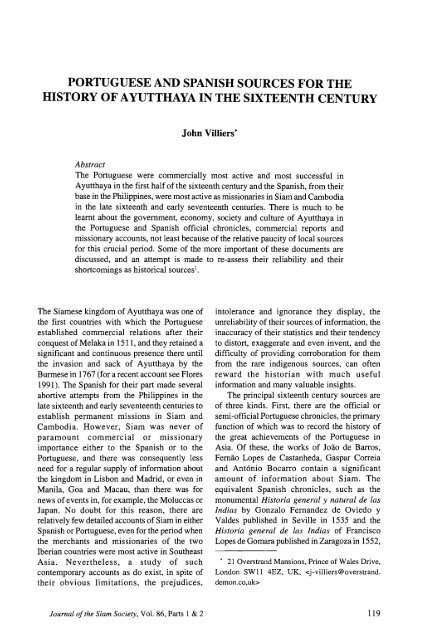The Journal of the Siam Society Vol. LXXXVI, Part 1-2 ... - Khamkoo
The Journal of the Siam Society Vol. LXXXVI, Part 1-2 ... - Khamkoo
The Journal of the Siam Society Vol. LXXXVI, Part 1-2 ... - Khamkoo
You also want an ePaper? Increase the reach of your titles
YUMPU automatically turns print PDFs into web optimized ePapers that Google loves.
PORTUGUESE AND SPANISH SOURCES FOR THE<br />
HISTORY OF A YUTTHAYA IN THE SIXTEENTH CENTURY<br />
John Villiers*<br />
Abstract<br />
<strong>The</strong> Portuguese were commercially most active and most successful in<br />
Ayutthaya in <strong>the</strong> first half <strong>of</strong> <strong>the</strong> sixteenth century and <strong>the</strong> Spanish, from <strong>the</strong>ir<br />
base in <strong>the</strong> Philippines, were most active as missionaries in <strong>Siam</strong> and Cambodia<br />
in <strong>the</strong> late sixteenth and early seventeenth centuries. <strong>The</strong>re is much to be<br />
learnt about <strong>the</strong> government, economy, society and culture <strong>of</strong> Ayutthaya in<br />
<strong>the</strong> Portuguese and Spanish <strong>of</strong>ficial chronicles, commercial reports and<br />
missionary accounts, not least because <strong>of</strong> <strong>the</strong> relative paucity <strong>of</strong> local sources<br />
for this crucial period. Some <strong>of</strong> <strong>the</strong> more important <strong>of</strong> <strong>the</strong>se documents are<br />
discussed, and an attempt is made to re-assess <strong>the</strong>ir reliability and <strong>the</strong>ir<br />
shortcomings as historical sources 1 •<br />
<strong>The</strong> <strong>Siam</strong>ese kingdom <strong>of</strong> Ayutthaya was one <strong>of</strong><br />
<strong>the</strong> first countries with which <strong>the</strong> Portuguese<br />
established commercial relations after <strong>the</strong>ir<br />
conquest <strong>of</strong>Melaka in 1511, and <strong>the</strong>y retained a<br />
significant and continuous presence <strong>the</strong>re until<br />
<strong>the</strong> invasion and sack <strong>of</strong> Ayutthaya by <strong>the</strong><br />
Burmese in 1767 (for a recent account see Flores<br />
1991). <strong>The</strong> Spanish for <strong>the</strong>ir part made several<br />
abortive attempts from <strong>the</strong> Philippines in <strong>the</strong><br />
late sixteenth and early seventeenth centuries to<br />
establish permanent missions in <strong>Siam</strong> and<br />
Cambodia. However, <strong>Siam</strong> was never <strong>of</strong><br />
paramount commercial or missionary<br />
importance ei<strong>the</strong>r to <strong>the</strong> Spanish or to <strong>the</strong><br />
Portuguese, and <strong>the</strong>re was consequently less<br />
need for a regular supply <strong>of</strong> information about<br />
<strong>the</strong> kingdom in Lisbon and Madrid, or even in<br />
Manila, Goa and Macau, than <strong>the</strong>re was for<br />
news <strong>of</strong> events in, for example, <strong>the</strong> Moluccas or<br />
Japan. No doubt for this reason, <strong>the</strong>re are<br />
relatively few detailed accounts <strong>of</strong> <strong>Siam</strong> in ei<strong>the</strong>r<br />
Spanish or Portuguese, even for <strong>the</strong> period when<br />
<strong>the</strong> merchants and missionaries <strong>of</strong> <strong>the</strong> two<br />
Iberian countries were most active in Sou<strong>the</strong>ast<br />
Asia. Never<strong>the</strong>less, a study <strong>of</strong> such<br />
contemporary accounts as do exist, in spite <strong>of</strong><br />
<strong>the</strong>ir obvious limitations, <strong>the</strong> prejudices,<br />
intolerance and ignorance <strong>the</strong>y display, <strong>the</strong><br />
unreliability <strong>of</strong> <strong>the</strong>ir sources <strong>of</strong> information, <strong>the</strong><br />
inaccuracy <strong>of</strong> <strong>the</strong>ir statistics and <strong>the</strong>ir tendency<br />
to distort, exaggerate and even invent, and <strong>the</strong><br />
difficulty <strong>of</strong> providing corroboration for <strong>the</strong>m<br />
from <strong>the</strong> rare indigenous sources, can <strong>of</strong>ten<br />
reward <strong>the</strong> historian with much useful<br />
information and many valuable insights.<br />
<strong>The</strong> principal sixteenth century sources are<br />
<strong>of</strong> three kinds. First, <strong>the</strong>re are <strong>the</strong> <strong>of</strong>ficial or<br />
semi-<strong>of</strong>ficial Portuguese chronicles, <strong>the</strong> primary<br />
function <strong>of</strong> which was to record <strong>the</strong> history <strong>of</strong><br />
<strong>the</strong> great achievements <strong>of</strong> <strong>the</strong> Portuguese in<br />
Asia. Of <strong>the</strong>se, <strong>the</strong> works <strong>of</strong> Joao de Barros,<br />
Fernao Lopes de Castanheda, Gaspar Correia<br />
and Antonio Bocarro contain a significant<br />
amount <strong>of</strong> information about <strong>Siam</strong>. <strong>The</strong><br />
equivalent Spanish chronicles, such as <strong>the</strong><br />
monumental Historia general y natural de las<br />
lndias by Gonza1o Fernandez de Oviedo y<br />
Valdes published in Seville in 1535 and <strong>the</strong><br />
Historia general de las lndias <strong>of</strong> Francisco<br />
Lopes de Gomara published in Zaragoza in 1552,<br />
• 21 Overstrand Mansions, Prince <strong>of</strong>Wa1es Drive,<br />
London SW11 4EZ, UK, <br />
<strong>Journal</strong> <strong>of</strong> <strong>the</strong> <strong>Siam</strong> <strong>Society</strong>, <strong>Vol</strong>. 86, <strong>Part</strong>s 1 & 2<br />
119

















